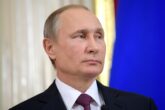May 03, 2021
China and Russia’s Dangerous Convergence
On March 23, Chinese Foreign Minister Wang Yi and his Russian counterpart, Sergey Lavrov, sat down for an auspiciously timed meeting. The high-level talks came just a day after an unusually heated public exchange between senior U.S. and Chinese officials in Anchorage, Alaska, and in sharp contrast, the Chinese and Russian foreign ministers struck an amicable tone. Together, they rejected Western criticism of their human rights records and issued a joint statement offering an alternative vision for global governance. The U.S.-led international order, Lavrov said, “does not represent the will of the international community.”
The meeting was noteworthy for more than its rhetoric, however. Within days of it, Russia began amassing troops along Ukraine’s border—the largest number since Moscow’s annexation of Crimea in 2014. Simultaneously, China began conducting highly publicized amphibious assault exercises and air incursions into Taiwan’s so-called air defense identification zone at the highest frequency in nearly 25 years. These military moves have reignited concerns in Washington about the potential depth of Chinese-Russian coordination.
Any effort to address either Russia’s or China’s destabilizing behavior must now account for the two countries’ deepening partnership.
For the United States, confronting these decidedly different adversaries will be a tall order, and the two countries will inevitably divide Washington’s attention, capabilities, and resources. The events of the last several weeks make clear that the administration of President Joe Biden will have difficulty managing Chinese behavior without addressing Moscow’s support for Beijing and that Washington must now calculate how its response to one adversary will shape the calculus of the other.
The problems the two countries pose to Washington are distinct, but the convergence of their interests and the complementarity of their capabilities—military and otherwise—make their combined challenge to U.S. power greater than the sum of its parts. China, in particular, is using its relationship with Russia to fill gaps in its military capabilities, accelerate its technological innovation, and complement its efforts to undermine U.S. global leadership. Any effort to address either Russia’s or China’s destabilizing behavior must now account for the two countries’ deepening partnership.
Read the full article from Foreign Affairs.
More from CNAS
-
Trump ‘Humiliated’ as Putin Sends Clear Message That He Doesn’t Care About US
"Putin is not playing ball." Putin's Palm Sunday attack on Sumy is "embarrassing for the White House" as it comes just days after Steve Witkoff met with the Kremlin, says adju...
By Jim Townsend
-
The Hidden Past and Uncertain Future of the U.S. and Ukraine with Celeste Wallander
Under the Trump administration, U.S. support for Ukraine is no longer guaranteed. President Trump's pause on aid and intelligence to Ukraine in March may have been brief, but ...
By Andrea Kendall-Taylor, Jim Townsend & Celeste Wallander
-
Is Russia Under Pressure?
Since 2014, the United States and its allies have provided increasing military support to Ukraine while imposing more and tougher economic sanctions on Russia, especially sinc...
By Jeffrey Edmonds
-
Sharper: Russia and the Axis of Upheaval
Russia’s 2022 invasion of Ukraine served as a dramatic catalyst for strengthening the global axis of upheaval. To sustain its war effort, Russia has imported Iranian weapons a...
By Charles Horn




